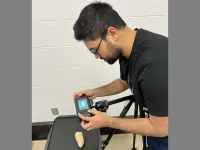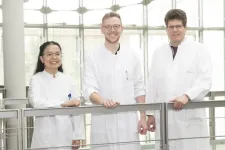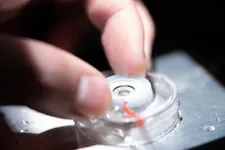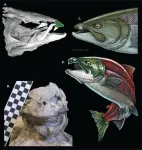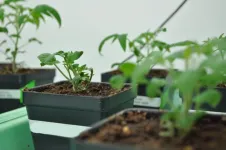(Press-News.org) URBANA, Ill. – Sweet potatoes are a popular food choice for consumers worldwide because of their delicious taste and nutritious quality. The red, tuberous root vegetable can be processed into chips and fries, and it has a range of industrial applications, including textiles, biodegradable polymers, and biofuels.
Sweet potato quality assessment is crucial for producers and processors because features influence texture and taste, consumer preferences, and viability for different purposes. A new study from the University of Illinois Urbana-Champaign explores the use of hyperspectral imaging and explainable artificial intelligence (AI) to assess sweet potato attributes.
“Traditionally, quality assessment is done using laboratory analytical methods. You need different instruments to measure different attributes in the lab, and you need to wait for the results. With hyperspectral imaging, you can measure several parameters simultaneously. You can assess every potato in a batch, not just a few samples. Spectral imaging is non-invasive, fast, accurate, and cost-effective,” said Mohammed Kamruzzaman, assistant professor in the Department of Agricultural and Biological Engineering (ABE), part of the College of Agricultural, Consumer and Environmental Sciences (ACES) and The Grainger College of Engineering at Illinois.
The study is part of a multi-state collaboration funded by the U.S. Department of Agriculture that includes researchers from Mississippi, North Carolina, Michigan, Louisiana, and Illinois. Each university addresses different aspects of the project; Kamruzzaman’s team focuses on the assessment of three chemical attributes — dry matter, firmness, and soluble sugar content (degree brix) — which affect the market price and whether a potato is suitable for the consumer or for processing.
The researchers use a visible near-infrared hyperspectral imaging camera to take images of sweet potatoes from two different angles. Analyzing the images produces spectral data, which are used to identify key wavelengths and develop color maps that display the distribution of desired attributes.
Hyperspectral imaging has become an important tool in agricultural and food processing research. However, it generates a vast amount of data that is processed with machine learning. It’s complex and typically acts like a black box, where users don’t know what is happening.
“We combine hyperspectral imaging with explainable AI, allowing us to understand the processes behind the results. It is a way to visualize how the machine learning algorithms work, how input data are processed, and how features are connected to predict the output,” said Md Toukir Ahmed, a doctoral student in ABE and lead author of the paper.
“We believe this is a novel application of this method for sweet potato assessment. This pioneering work has the potential to pave the way for usage in a wide range of other agricultural and biological research fields as well.”
The results can help industry professionals and researchers understand the significance of different features in predicting quality attributes, which leads to more informed decision-making and ensures supplies of higher-quality products to consumers.
Kamruzzaman said one goal of the multi-university project is to develop a tool that processors can use to quickly and easily scan batches of sweet potatoes to determine features and attributes. Eventually, researchers could create a mobile app consumers can use in the grocery store to scan the quality of sweet potatoes at the point of purchase.
The paper, “Advancing sweetpotato quality assessment with hyperspectral imaging and explainable artificial intelligence,” is published in Computers and Electronics in Agriculture [doi.org/10.1016/j.compag.2024.108855].
This work was funded by the U.S. Department of Agriculture Agricultural Marketing Service through the Specialty Crop Multistate Program grant AM21SCMPMS1010. The contents are solely the responsibility of the authors and do not necessarily represent the official views of the USDA.
END
Sweet potato quality analysis is enhanced with hyperspectral imaging and AI
2024-04-24
ELSE PRESS RELEASES FROM THIS DATE:
Use of acid reflux drugs linked to higher risk of migraine
2024-04-24
EMBARGOED FOR RELEASE UNTIL 4 P.M. ET, WEDNESDAY, APRIL 24, 2024
MINNEAPOLIS – People who take acid-reducing drugs may have a higher risk of migraine and other severe headache than people who do not take these medications, according to a study published in the April 24, 2024, online issue of Neurology® Clinical Practice, an official journal of the American Academy of Neurology. The acid-reducing drugs include proton pump inhibitors such as omeprazole and esomeprazole, histamine H2-receptor antagonists, or H2 blockers, such as cimetidine and famotidine, and antacid supplements.
The study does not prove that acid-reducing drugs cause migraine; ...
For immigrants to Canada, risk of MS increases with proportion of life spent there
2024-04-24
EMBARGOED FOR RELEASE UNTIL 4 P.M. ET, WEDNESDAY, APRIL 24, 2024
MINNEAPOLIS – Immigrants to Canada who have spent a greater proportion of their lives in Canada have a greater risk of developing multiple sclerosis (MS) than people who have spent a smaller proportion of their lives there, according to a study published in the April 24, 2024, online issue of Neurology®, the medical journal of the American Academy of Neurology. The study does not prove that an increased proportion of life in Canada causes MS; ...
Targeted use of enfortumab vedotin for the treatment of advanced urothelial carcinoma
2024-04-24
Under the leadership of PD Dr. Niklas Klümper, Assistant Physician at the Department of Urology at the University Hospital Bonn (UKB) and Clinician Scientist of the BMBF-funded ACCENT program and PD Dr. Markus Eckstein, senior physician at the Institute of Pathology at the Uniklinikum Erlangen of the Friedrich-Alexander-University Erlangen-Nürnberg (FAU), an interdisciplinary research team has published new findings that indicate which patients with advanced urothelial carcinoma could benefit in particular from the new targeted therapy with the antibody-drug conjugate enfortumab ...
A university lecture, with a dash of jumping jacks
2024-04-24
COLUMBUS, Ohio – A university professor has found a way to help students – and himself – power through long lecture classes: exercise breaks.
In a new study, a professor at The Ohio State University showed that five-minute exercise sessions during lectures were feasible and that students reported positive impacts on their attention and motivation, engagement with their peers and course enjoyment.
The results may not be particularly surprising, but they do suggest a solution ...
How light can vaporize water without the need for heat
2024-04-24
It’s the most fundamental of processes — the evaporation of water from the surfaces of oceans and lakes, the burning off of fog in the morning sun, and the drying of briny ponds that leaves solid salt behind. Evaporation is all around us, and humans have been observing it and making use of it for as long as we have existed.
And yet, it turns out, we’ve been missing a major part of the picture all along.
In a series of painstakingly precise experiments, a team of researchers at MIT has demonstrated that heat isn’t alone in causing water to evaporate. Light, striking the water’s surface where air and water meet, can break water molecules away and float ...
These giant, prehistoric salmon had tusk-like teeth
2024-04-24
Oncorhynchus rastrosus, a giant species of salmon that lived in the North American Pacific Northwest a few million years ago, sported a pair of front teeth that projected out from the sides of its mouth like tusks, according to a study published April 24 in the open-access journal PLOS ONE by Kerin Claeson from the Philadelphia College of Osteopathic Medicine, USA, and colleagues.
O. rastrosus, first described in the 1970s, has been estimated to reach up to 2.7 meters (8.9 feet) long, making it the largest member of the Salmonidae family ever discovered. Initially, researchers thought its oversized front teeth pointed backward into the mouth like fangs, in large ...
New study infers our wellbeing by analyzing the language we use around ageing, using language markers to enable "a different type of access to individuals’ inner worlds"
2024-04-24
New study infers our wellbeing by analyzing the language we use around ageing, using language markers to enable "a different type of access to individuals’ inner worlds"
###
Article URL: https://journals.plos.org/plosone/article?id=10.1371/journal.pone.0302103
Article Title: When I am sixty-four… evaluating language markers of well-being in healthy aging narratives
Author Countries: Switzerland, USA, Australia
Funding: Funding by the Jacobs Foundation (https://jacobsfoundation.org/en/; awarded to TM) and the Swiss National Science Foundation SNF ((https://www.snf.ch/en/; fellowship P2ZHP1_199409 ...
New research confirms plastic production is directly linked to plastic pollution
2024-04-24
APRIL 24, 2024 – A research paper published today in Science Advances reveals a direct correlation between plastic production and plastic pollution, such that every 1% increase in plastic production is associated with a 1% increase in plastic pollution in the environment. The study finds that fast-moving consumer goods companies disproportionately contribute to the problem more than household and retail companies. The study marks the first robust quantification of the global relationship between plastic production and pollution.
The research, led by scientists ...
MSU researchers uncover 'parallel universe' in tomato genetics
2024-04-24
In a new paper appearing in Science Advances, Michigan State University researchers have unraveled a surprising genetic mystery centered on sugars found in what gardeners know as “tomato tar.”
Anyone who has pruned tomato plants barehanded has likely found their fingers darkened with a sticky, gold-black substance that won’t quite wash off.
This tomato tar is sticky for good reason. It’s made of sugars — acylsugars, to be precise — and acts as a sort of natural flypaper for ...
Grey cuckoo, red cuckoo: unveiling the genomic secrets of color polymorphism in female cuckoo birds
2024-04-24
NEW YORK, April 24, 2024 — Sexual dimorphism—the visible difference between females and males—can be seen in diverse animals, including humans. One intriguing aspect of this phenomenon is sex-limited polymorphism, where one sex displays greater variations in a particular trait than the other. In a recent study published in Science Advances, a team of researchers delve into the genetic underpinnings behind the color polymorphism observed in adult females of the brood parasitic Cuculus, more widely known as cuckoo birds, shedding light on the evolution and functional significance of this phenomenon.
Several species of cuckoos, a genus of birds ...
